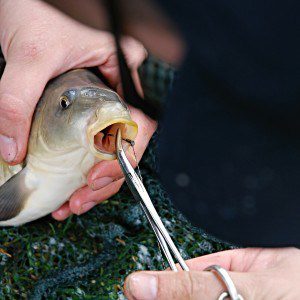In the 17th century, philosopher René Descartes posited that animals are not conscious, and therefore, are unable to feel pain or suffering.1 While we’ve come much further in our understanding since then, many scientists concluding that a large number of animals are indeed conscious and do have a capacity for suffering2,3, we have still yet to widely recognize these characteristics in fish.
The question “Do fish feel pain?” finally became the topic of several studies in the past few decades. One experiment4 involved electrically shocking toadfish in order to observe their responses to stimuli that would normally be painful for humans and other mammals. It was found that the toadfish would “grunt” whenever they were shocked. After some time, the toadfish began to grunt at the sight of an electrode, without yet being shocked. While these findings in themselves do not conclusively prove that fish feel pain, they do show that fish exhibit similar pain-response and pain-association behaviors seen in us and other animals.
 In another study5, fish had their lips injected with chemicals that would produce a painful sensation – if the fish could feel it. Before they received the injections, the fish showed normal behaviors. After, however, the fish began to rub their lips against the gravel and walls of their tanks. This seemed to be an attempt to get rid of the sensation they were feeling, for it was apparent that the injections did cause the fish to feel some sort of sensation. It was also found that their breathing rate nearly doubled. The researchers then treated the fish with morphine.
In another study5, fish had their lips injected with chemicals that would produce a painful sensation – if the fish could feel it. Before they received the injections, the fish showed normal behaviors. After, however, the fish began to rub their lips against the gravel and walls of their tanks. This seemed to be an attempt to get rid of the sensation they were feeling, for it was apparent that the injections did cause the fish to feel some sort of sensation. It was also found that their breathing rate nearly doubled. The researchers then treated the fish with morphine.
If what they were experiencing was indeed pain, it was expected that the fish would stop rubbing their lips and their breathing rate would lower, as the pain would be eased by the medication. This is exactly what happened. The fish began to rub their lips much less, and their breathing rate lowered significantly as well.
The scientists concluded that the behaviors they observed were not merely reflexes, but rather, likely to be responses to pain felt. The same research team did further studies on fish pain, and also found that when experiencing painful stimuli, the neurons of both humans and fish brains fire in the same way.6
A 2009 experiment7 done by another group also tested how fish responded to painful stimuli. One set of fish were given morphine, and another set was given saline. Then, they were exposed to hot water. All of the fish tried to escape the heat, but the ones that received the pain-relieving morphine had slower responses. After the initial exposure, the fish would avoid the heat source. “The experiment shows that fish do not only respond to painful stimuli with reflexes, but change their behavior also after the event. Together with what we know from experiments carried out by other groups, this indicates that the fish consciously perceive the test situation as painful and switch to behaviors indicative of having been through an aversive experience.” said the study lead, Janicke Nordgreen.
Many of those who criticize the conclusions of these studies say that fish lack the brain parts necessary for awareness and processing pain, namely, the neocortex, found only in mammals. However, it has been found in many different species that though they lack the same brain parts, anatomies, and/or physiologies, they have still evolved to share some of the same abilities. This phenomenon is called convergent evolution. An example of this would be the case of birds and self-recognition: it was thought that birds could not recognize themselves because they also do not have a neocortex. Yet Eurasian magpies demonstrated their ability for self-recognition by passing the mirror test. This shows that in birds, different brain parts could be responsible for this ability.
So can we conclude that fish feel pain based on the research conducted up till now? Fish behavior researcher Culum Brown said in a recent paper8: “A review of the evidence for pain perception strongly suggests that fish experience pain in a manner similar to the rest of the vertebrates. Although scientists cannot provide a definitive answer on the level of consciousness for any non-human vertebrate, the extensive evidence of fish behavioural and cognitive sophistication and pain perception suggests that best practice would be to lend fish the same level of protection as any other vertebrate.”
To read more about the evidence for pain-feeling in fish, read Victoria Braithwaite’s book Do Fish Feel Pain?
This interview was conducted by Amanda Pachniewska, founder & editor of AnimalCognition.org
Sources
1 – René Descartes
Animals are Machines
http://cosmology.com/Consciousness136.html
2 – Peter Singer
Animal liberation. Towards an end to man’s inhumanity to animals.
Animal Liberation
http://www.cabdirect.org/abstracts/19801495249.html;jsessionid=90CA4E13D4572F51386FC435FE71D6A1
3 – Rollin, Bernard
The Unheeded Cry: Animal Consciousness, Animal Pain, and Science.
http://www.amazon.com/Unheeded-Cry-Bernard-Rollin/dp/0557578213/ref=sr_1_3?ie=UTF8&qid=1429728303&sr=8-3&keywords=The+Unheeded+Cry%3A+Animal+Consciousness%2C+Animal+Pain%2C+and+Science.
4 – Dunayer, Joan
Fish: Sensitivity Beyond the Captor’s Grasp
The Animals’ Agenda
5 – Lynne U Sneddon
The evidence for pain in fish: the use of morphine as an analgesic
Applied Animal Behaviour Science
http://www.appliedanimalbehaviour.com/article/S0168-1591(03)00113-8/abstract
6 – Victoria Braithwaite
Do Fish Feel Pain?
http://www.amazon.com/Fish-Feel-Pain-Victoria-Braithwaite/dp/0199551200/ref=cm_cr_pr_product_top?ie=UTF8
7 – Janicke Nordgreen, et al.
Thermonociception in fish: Effects of two different doses of morphine on thermal threshold and post-test behaviour in goldfish (Carassius auratus)
Applied Animal Behaviour Science
http://www.sciencedirect.com/science/article/pii/S0168159109001051
8 – Culum Brown
Fish intelligence, sentience, and ethics
Animal Cognition
http://link.springer.com/article/10.1007/s10071-014-0761-0#


